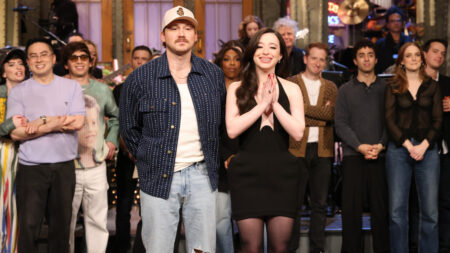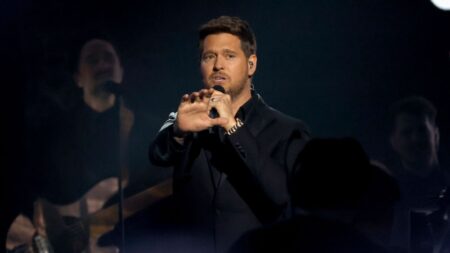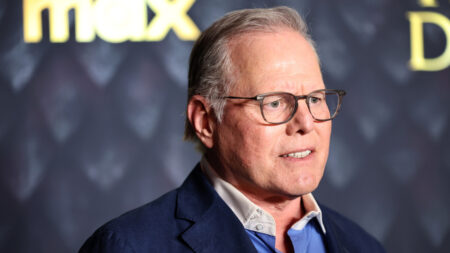The maximum-intensity jolt to the senses that is Warfare knows exactly what it’s doing by opening with a scene of collective levity and back-slapping brotherhood that might have been lifted from a frat-boy comedy. We could almost be watching The Substance 2 as a statuesque blonde in a skimpy leotard leads a group through a sexualized workout routine heavy on the pump and thrust. Cut from that low-res video to a platoon of Navy SEALS at their base, clustered around a screen, loudly whooping and shouting like beer-soused football stadium spectators.
These are the young men with whom we will be embedded for the next viscerally immersive 90 minutes in a real-time account of a 2006 mission in Ramadi, Iraq, as a U.S. sniper unit negotiates a hotbed of Al Qaeda insurgency. The stacked cast of young talent includes Joseph Quinn, Charles Melton, D’Pharaoh Woon-A-Tai, Will Poulter, Cosmo Jarvis and Kit Connor. It’s fitting, however, that the rowdy introduction presents them not as individuals but as one heaving mass of testosterone.
Warfare
The Bottom Line
Unflinching realism that leaves you breathless.
Release date: Friday, April 11
Cast: D’Pharaoh Woon-A-Tai, Will Poulter, Cosmo Jarvis, Kit Connor, Finn Bennett, Taylor John Smith, Michael Gandolfini, Adain Bradley, Noah Centineo, Evan Holtzman, Henrique Zaga, Joseph Quinn, Charles Melton
Director-screenwriters: Ray Mendoza, Alex Garland
Rated R,
1 hour 35 minutes
Co-written and directed by Alex Garland with his military advisor on Civil War, Ray Mendoza, a former Navy SEAL who served in Iraq and was part of the hair-raising mission, the movie takes its place alongside nail-biting combat dramas like The Hurt Locker and Black Hawk Down.
But Warfare also feels different. Character detail is reduced to whatever behavior we observe in the men under pressure. There’s no gung-ho bravado, no talk of wives or girlfriends back home, no romanticization of war or political speechifying, no “U.S.A!” jingoism, no exposition. What there is, instead, is raw feeling — fear and pain as much as courage, adrenaline, decisiveness and determination, along with disorientation as chaos escalates, often with minimal visibility. While the situation is too messy and the action too real for movie-ish displays of camaraderie, we’re aware at all times of the extraordinary degree to which these men are looking out for each other.
That means that although roughly half their dialogue is terse communication of strictly necessary information laced with military jargon — either via radio transmitter with other units or among members of the group — we come to care about these characters. Which is remarkable in an ensemble drama with zero backstories; in many cases, we barely get to know the soldiers’ names. But not knowing much about them somehow makes the movie even more powerful in its blunt-force depiction of the brutality of war and the human faces behind it.
At a time when international relations are more often shaped by economic advantage and political power grabs than humanitarian intervention, there’s something profoundly affecting about this unvarnished depiction of frontline combat. It’s a timely reminder that when governments opt into wars for whatever reason, it’s people who should have their whole lives ahead of them that generally pay the price, whether it’s death or injury or trauma.
As the platoon files along an empty residential street in darkness, a couple of them are still mimicking the sexy workout moves. But that clowning gets abruptly switched off in the unnerving quiet once the senior officer identifies a strategically positioned house in which to set up his sniper unit.
With the aid of Iraqi interpreters (Heider Ali and Nathan Altai), they wake the startled family who live there and then with less diplomacy, sledgehammer their way through a bricked-up access point into a separate upstairs apartment, where another terrified family huddles against a wall. The occupants are all herded into a room and instructed to remain quiet while the soldiers set up positions from which to surveil the surrounding streets, connected by a busy open-air marketplace. Their mission is to ensure the area is clear for ground forces to pass through the following day.
But what should have been a standard maneuver becomes a survival ordeal once they discover their proximity to an insurgent house. The directors keep the tension humming quietly through the initial period of silence and waiting, then dial it way up when people hurriedly leave the marketplace just before jihadists lob a grenade through a sniper hole, signaling the start of a sustained attack.
From that moment on, as soldiers stagger around blindly in the dust from the explosion, a couple of them seriously wounded, Warfare seldom stops for breath. A barrage of machine-gun fire and IED blasts hammers away at our nerves to an extent that puts us directly in the combat boots of the platoon as initial extraction attempts are thwarted and air support stymied by Al Qaeda snipers positioned on the roofs.
The pounding effectiveness of Glenn Freemantle’s sound design cannot be overstated. The same goes for the agility of DP David Thompson’s mostly handheld cameras and the relentless rhythms of Fin Oates’ editing, conveying an atmosphere of maximum urgency and minimal time to think.
This is painstakingly choreographed filmmaking as sustained high-wire act, though at no time does the sensory overload sacrifice verisimilitude to sensationalism. Even gasp-inducing shots like a jet swooping in low along the residential street never take us out of the life-or-death situation for a single second; nor do the many virtuosic extended takes call attention to themselves. Production designer Mark Digby’s extensive recreation of the urban neighborhood (on a former WWII airfield outside London) is impeccable, both in the quiet buildup and the rubble-strewn aftermath.
Garland is working in peak form and with dazzling technical command in what’s arguably his best film since his debut, Ex Machina. But the director’s skill with the compressed narrative would be nothing without the rigorous sense of authenticity and first-hand tactical knowledge that Mendoza brings to the material — and no doubt to the commitment of the actors.
There are no star turns among the tight ensemble, who undertook three weeks of intensive Navy SEAL boot-camp training to prepare for the shoot, and no weak link either. All of them are working in service of the unit, not the individual.
That said, there are searing moments of pathos from Jarvis (Shōgun) as Elliott, the most gravely wounded of the troop, screaming in agony as he’s dragged across the floor to relative safety, trailing blood. As Sam, another severely wounded soldier, Quinn (A Quiet Place: Day One) pulls us into the harrowing conflict with equal parts stoicism and vulnerability; Poulter (On Swift Horses) does fine work as Captain Erik, in charge of the first operation, at one point freaked out and frozen; and Melton (May December) brings quick-thinking authority to Jake, the officer leading the second operation.
Woon-A-Tai (so unforgettable in Reservation Dogs) is a compelling presence as co-director Mendoza, communications officer for the first operation, constantly weighing the balance between base commands and the necessity of the men to improvise in order to survive. And there’s poignancy and glimmers of understated humor from Connor (Heartstopper) as Tommy, a gunner whose bright-eyed “new guy energy” quickly dissipates once the situation turns hairy, causing him to inject morphine into his own thumb during a fumbled attempt to administer pain relief to Elliott.
As courageous as the platoon members are, Warfare is not to be confused with a movie about heroism; it’s a movie about hell that leaves you shaken. The filmmakers are smart in allowing that impression to resonate unfiltered, ending not with the relief of rescue and the release of tension, but with the Iraqi occupants cautiously stepping out into what’s left of their home as jihadists regroup on the empty street.
Mendoza and Garland have crafted a bold new landmark in screen depictions of combat that makes for can’t-look-away real-life drama.
Read the full article here
















